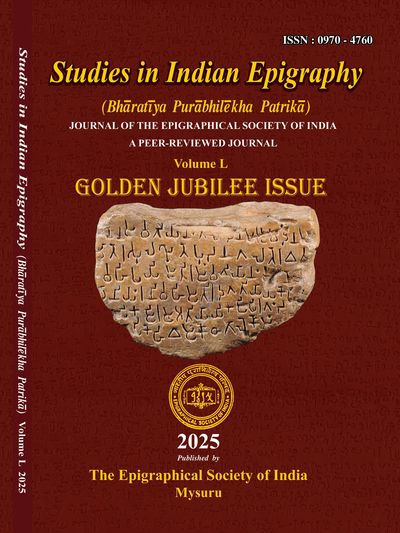Publication Policy
Peer Review Process
All articles submitted to Studies in Indian Epigraphy are initially assessed by an Assistant Editor, Editorial board and Editor. The Editor finally decides whether the article is suitable for peer review or not. Article considered suitable are assigned to two external experts, who assess the article for its content, originality, methodology and validity of conclusions.
The journal Studies in Indian Epigraphy operates a double-blind peer review process, meaning that authors and reviewers remain anonymous for the review process. The review period is expected to take around four to eight weeks, although this may vary depending on reviewer availability. Reviewers are asked to provide formative feedback, even if an article is not deemed suitable for publication in the journal.
Based on the reviewer reports the editor will make a recommendation for rejection, minor or major revisions, or acceptance. Overall editorial responsibility rests with the journal’s Editor, who is supported by Assistant Editor and Editorial Board.
The journal Studies in Indian Epigraphy only publishes those articles presented in their annual conferences.
The Editor, Assistant Editor and members of the editorial board are permitted to submit their own papers to the journal. In cases where an author is associated with the journal, they will be removed from all editorial tasks for that paper and another member of the team will be assigned responsibility for overseeing peer review. A competing interest must also be declared within the submission and any resulting publication.
Reviewer Guidelines
Reviewers are asked to provide comment on the below topics and guidelines:
· Content: Does the article fit within the scope of the journal? Is the submission original, relevant and rigorous? Is the author’s depth of understanding of the issues researched adequate? Are the sources and references adequate? Has the existing knowledge base been explored and built upon? Are the chosen methodologies appropriate and have they and the evidential base been appropriately used? Does the conclusion reflect the argument in the main body text and bring something new to the debate?
· Structure and argument: Does the abstract summarise the arguments in a succinct and accurate way? Is the manuscript logically structured and do the arguments flow coherently? Is there enough reference to methodology in the introduction and are the arguments fully evidenced and substantiated? Does the introduction signpost the arguments in the logical way and does the conclusion adequately summarise them?
· Figures/tables: Does the author’s use of tables, charts, figures or maps illustrate the arguments and support the evidential base? Is the quality of the formatting and presentation adequate?
· Formatting: Does the submitted file adhere to the general author guidelines listed for the journal? Are the citations and references formatted to house-style?
· Language: Is the text well written and jargon free? Please comment on the quality of English and need for grammatical improvement.
Authorship
All listed authors must qualify as such, as defined in our author’s guideline. All authors must have given permission to be listed on the submitted paper.
Competing Interests, Funding and Ethics
To ensure transparency, all authors, reviewers and editors are required to declare any interests that could compromise, conflict or influence the validity of the publication. All authors must confirm that they fit the definition of an author (see Authorship Guidelines), during submission.
Corrections and Retractions
In accordance with guidelines from the Committee on Publication Ethics (where applicable), the Press handles different kinds of error. All articles have their proofs checked prior to publication by the author/editor, which should ensure that content errors are not present. Please contact the journal if you believe an article needs correcting.
Expected behaviour
The journal does not tolerate abusive behaviour or correspondence towards its staff, academic editors, authors, or reviewers. Any person engaged with the journal that resorts to abusive behaviour or correspondence will have their contribution immediately withdrawn and future engagement with the journal will be at the discretion of the editor and/or publisher.

This website uses cookies.
We use cookies to analyze website traffic and optimize your website experience. By accepting our use of cookies, your data will be aggregated with all other user data.